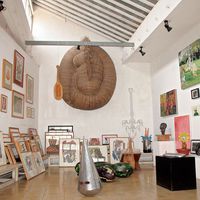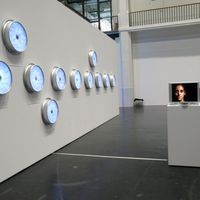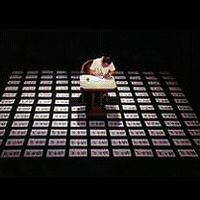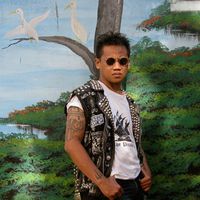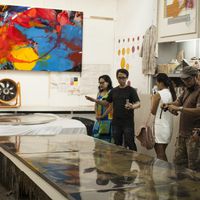Beyond the East: A Eurocentric gaze on Indonesian contemporary art
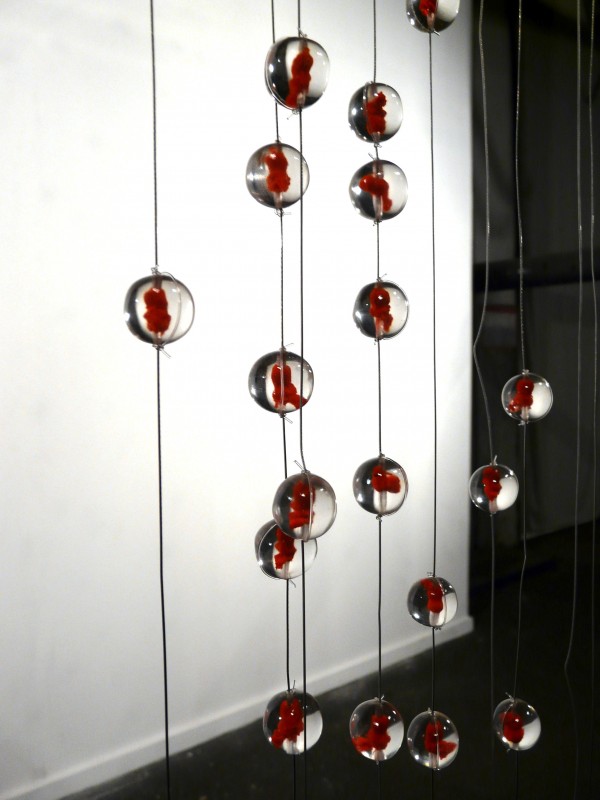 [caption id="attachment_18417" align="aligncenter" width="480" caption="Titarubi - Statistic of Bawling, 2011"]
[caption id="attachment_18417" align="aligncenter" width="480" caption="Titarubi - Statistic of Bawling, 2011"]From October 2011 to February 2012, the city of Rome presents an extensive programme of events in the frame of the international cultural biennale Vie della seta (Silk Roads). Organised by the Ministry of Foreign Affairs and the Italian Ministry of Culture, the biennale is dedicated to Middle and Far Eastern countries which, according to the concept of the festival, "constituted a mystery for Europe before Marco Polo's travels in the 13th century".
As part of the programme, the exhibition Beyond the East: A Gaze on Indonesian Contemporary Art, shows works by 15 established and renowned artists who live and work in Indonesia.
The world's biggest archipelago, is a plural and multicultural country with a long history of trade and a variety of foreign cultural influences, that includes elements from the Arabic world, China, India, the Netherlands (Indonesia was a Dutch colony for around 350 years, until 1949) and Portugal. In this dynamic and culturally diverse country, artists' initiatives play a major role in the establishment of artistic discourses and the promotion of contemporary art practice. The lack of public infrastructure for contemporary arts left the way open to artists to create their own platforms based on networking, dissemination of information and collaboration.
Regarding this, artists are aware of current socio-political changes in contemporary Indonesian society and depict some of these issues in their works. For instance, the installation of Titarubi, that refers to child birth in Indonesia. For this work, the artist took some autobiographical notes, as her mother was a midwife and her parent's house once served as a maternity home. The installation Statistic of Bawling (2011) is composed by three pieces of a series of small fiber glass balls with tiny red foetus' figures attached to several string rows. Each one of the series of rows represents real statistics. The first piece shows the number of infant births per day (around 12,300), the second is about infant mortality per day (750), and the third describes the number of abortions or misbirths per day (6,840). The installation itself is a reflection on the complexities of family planning, religion and gender in Indonesia.
Another example is This Shirt Fits Us All (2009) by Mella Jaarsma. The installation, composed by seven wearable pieces and a video, is a critique on the role of fashion in society that usually does not take into account cultural differences. This is illustrated through clothes with printed images of the body of a Papuan woman and young urban women doing a cat walk with these outfits. However, the curatorial concept of the exhibition does not coincide with the displayed works and is not giving any reference on current issues in contemporary Indonesia. The curator of the exhibition, Dominique Lora, prefers to talk about a sacred or traditional view of art, portraying the artists as shamans, mutants or minotaurs.
[caption id="attachment_18418" align="aligncenter" width="560" caption="FX Harsono - Monumen Bong Belung, 2011"]
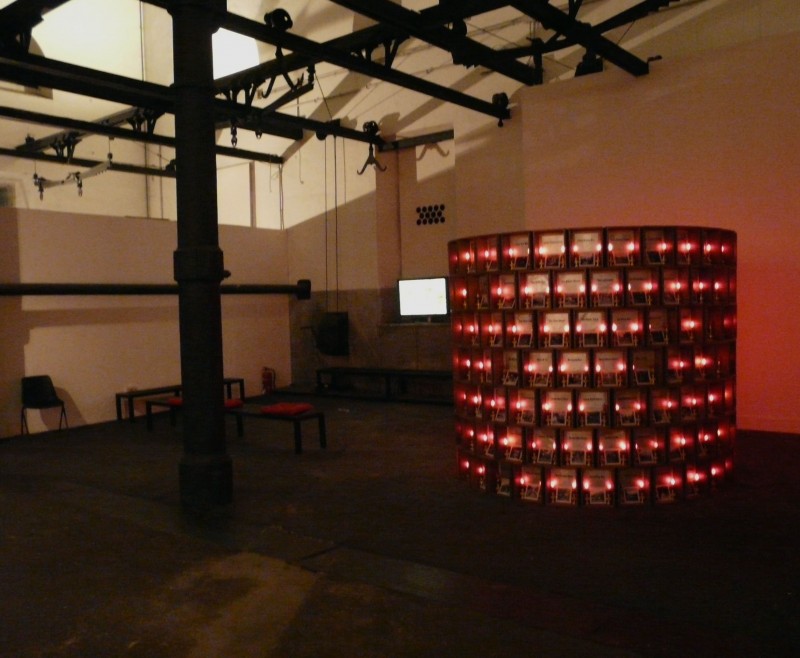 [/caption]
[/caption]In general, the attention is given to the mystical, the soul and spirit of the artist, although some of the works address concrete topics in Indonesian society, such as the installation Monumen Bong Belung (Bone Cementery Monument) (2011) by FX Harsono, a reminder of the victims of one of the massacres against Chinese-Indonesian minorities, who were killed by the indigenous population in the village of Blitar between 1947-48. Actually, to consider Indonesian contemporary art as solely embedded in tradition discards further possibilities of interpretation and understanding of this particular art scene.
Furthermore, the title of the exhibition refers to a geographical area: the East, or to be more precise: Beyond the East. The question is if this is a geopolitical framework or just a geographical positioning of a country, that is closer to Australia (considered as part of 'Western' culture) than to China. The exhibition gives a Eurocentric dialectic view of the East versus the West, as two separated and foreign worlds. In the catalogue, the curator describes the West as rational versus a traditional and emotional East: Eastern emotional intelligence prevails over the brand of Western rationality which had been dominating the world, in a dialogue that seems to be unable to communicate.
Paradoxically, both the exhibition and the biennale are based on dated categories. The biennale itself assumes that the 'East' existed after Marco Polo's journeys in Asia. As we know, the Silk Road was a trade route prior to the arrival of Marco Polo in Asia, to be precise: it started in China during its expansion towards the West, and allowed a way of cultural exchange between different cultures. Some people even consider it as the beginning of global culture. Thus, let's update and see art in a global context, in which virtual communication, technology and mobility are the basis for the exchange of ideas and cultural mixture, beyond nationalities or ideological borders.
[caption id="attachment_18419" align="aligncenter" width="537" caption="Mella Jaarsma - This Shirt Fits Us All, 2009"]
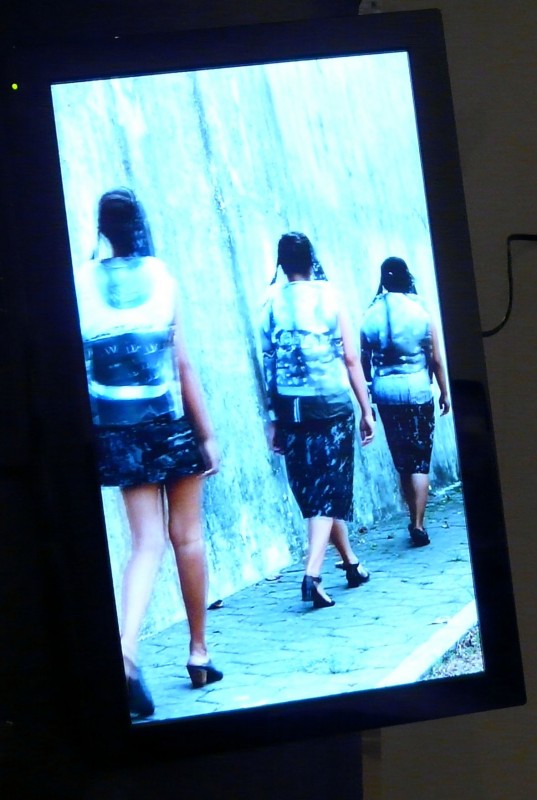 [/caption]
[/caption]Below the interview held with Dominique Lora, curator of the exhibition:
What inspired you to do an exhibition on Indonesian contemporary art?
The artist today is primarly engaged in negotiating the terms for the creation of a novel international culture, a culture based on differences and singularities as opposed to a general alignment to standardisation. The real challenge for contemporary artists, hence consists in developing specific alphabets and narratives, that, recurring to different logics, can overcome to the risks presented by the capitalist globalisation processes. The artist is not only responsible for its own research and production but is yet required to orchestrate and organise its own modes of display and market strategies.
How do you see Indonesian art as a foreign curator?
For a long time, collectors, galleries and auction houses only assimilated the speculative side of the art market and flourished according to an auto-referential dynamic ignoring the rules and values concurred upon by the international market. Misapprehending the meaning of art practice, such an oligarchic economy slowly contaminated the market with devastating financial operations. Now, new contemporary art audience is converging into a movement constituted by young artists, performers and fashion designers who concentrate their efforts in conveying their ideas in reshaping the meaning and function of art.
Why did you choose the title "Beyond the East"? Is there any geopolitical sense behind it?
Yes, as we often regard China, India and Japan as major forces, it is time to consider Southeast Asia as one of them on the same plan, although on different point of of view and approach.
I was curious about why did you ask the artists the Proust Questionnaire*. Is it also part of the concept of the exhibition?
It is a way to humanise the artists, in which their culture and lives are far away from Western culture and far from the Italian public. As you might now, few people take the effort to really read the essays, so I thought that those intriguing but familiar questions after all might interest the public to understand better the artists' emotional dimension.
What are the connections between the artworks? Is there any central theme that connects them?
Of course, the bond the with tradition, territory and memory. The exhibition is a visual, resounding, playful and aggressive ground in search for identity.
* The Proust Questionnaire is a questionnaire about one's personality. Its name and modern popularity as a form of interview is owed to the responses given by the French writer Marcel Proust.
For more information about the exhibition visit www.viedellaseta.roma.it
Beyond the East: A Gaze on Indonesian Contemporary Art
Artists: Agus Suwage, Astari Rasyid, Arya Pandjalu, Budi Kustarto, Eko Nugroho,
Entang Wiharso, FX Harsono, Heri Dono, Mella Jaarsma, Melati Suryodarmo,
Made Wianta, S Teddy D, Titarubi, Ugo Untoro and Yuli Prayitno
Photo credits:
Titarubi
Statistics of Bawling, 2011
Fiber glass, stainless steel, string and steel string
385 x 120 cm (3 pieces)
Photo: © Katerina Valdivia Bruch
Mella Jaarsma
This Shirt Fits Us All, 2009
7 garments, digital print on canvas, fabric
Video 2''
Dimensions variable
Photo: © Katerina Valdivia Bruch
FX Harsono
Monumen Bong Belung, 2011
Mixed-media installation
270 x 270 x 210 cm
Photo: © Katerina Valdivia Bruch
Katerina Valdivia Bruch is a Berlin-based independent curator. She has curated exhibitions for a number of institutions, including CCCB (Barcelona, Spain), Instituto Cervantes (Berlin and Munich), Instituto Cultural de Leon (Mexico), Para/Site Art Space (Hong Kong), and the Institute of Contemporary Arts Singapore, LASALLE College of the Arts. In 2008, she was co-curator of the Prague Triennale at the National Gallery in Prague. Besides her work as a curator, she contributes with essays and articles for art publications and magazines. Since 2009, she has organised a number of talks and exhibitions on Indonesian contemporary art. Her latest project Moving Images from Indonesia was presented during the sessions 'Curating in Asia' of the exhibition The Global Contemporary – Art Worlds After 1989 at ZKM – Center for Art and Media Karlsruhe. Currently, she is doing a curatorial residency at the Langgeng Art Foundation in Yogyakarta, Indonesia.
www.artatak.net
Similar content
from - to
12 Feb 2010 - 09 May 2010
posted on
20 Dec 2012

